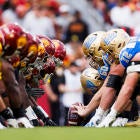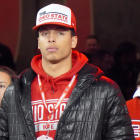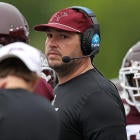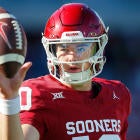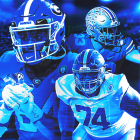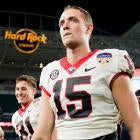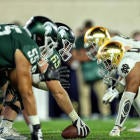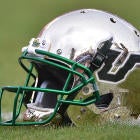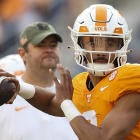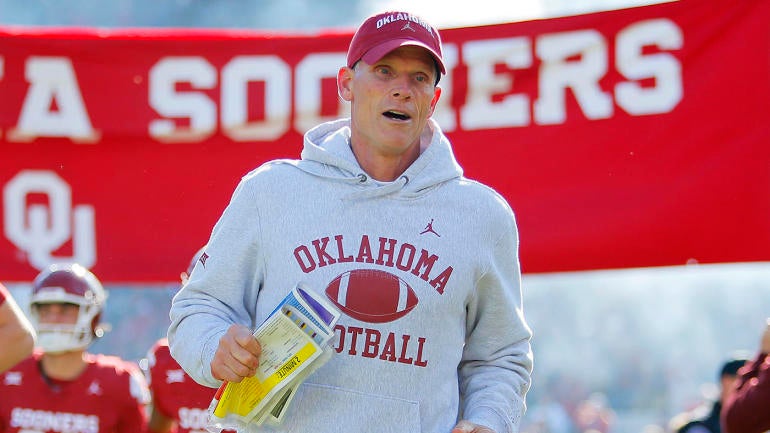
Oklahoma has reportedly extended coach Brent Venables for six years. It comes with a decent raise for Venables, whose job is about to become more difficult with the Sooners moving to the SEC on July 1 for the 2024 season.
Venables is 16-10 in two seasons with the Sooners, including a mark of 10-8 in conference play. Those are mediocre numbers, considering Venables is at the helm of the Big 12's most dominant program. It's the kind of mark that causes many people to raise an eyebrow upon hearing about an extension.
So why did Oklahoma do this now rather than wait to see how things go in their first SEC season?
There's an obvious surface reason. Venables was in Year 3 of a six-year deal. An extension now lets recruits know that Venables isn't on a "hot seat," and a possible rough start (have you seen Oklahoma's 2024 schedule?) won't be used against him and the Sooners on their new recruiting trail.
A far more demonstrative reason can be found when Oklahoma athletic director Joe Castiglione introduced Venables in December 2021 as the successor to Lincoln Riley. The emphasis added is mine.
"This is a truly great day for Oklahoma - for our program, our current players, former players, recruits and fans. Coach Venables is a proven winner, who over the years has helped his teams earn 13 conference championships and three national titles, and has developed one of the country's consistently best defenses. A born leader, he helped build and sustain an exceptional culture during his 13 years here at Oklahoma and his 10 seasons at Clemson. He has a track record of establishing meaningful relationships with his players and preparing them for the next level. Brent embraces competition and the challenges that come with it, and there is no doubt in my mind he is the right man to lead OU football into its next great era."
The end of the Riley era created a lot of revisionist history. You didn't hear a lot of complaints about Riley's program when it won four Big 12 titles and produced exciting offenses led by Heisman Trophy winners Baker Mayfield and Kyler Murray. However, the foundations of the complaints were evident in Oklahoma's postseason failures; too often, the team's defense proved too difficult to overcome against other elite programs.
Riley's teams reached the College Football Playoff in his first three seasons as coach but never won a game. While nobody will ever forget the thrilling 54-48 double-overtime loss to Georgia in the 2018 Rose Bowl, the Sooners weren't nearly as competitive in a 45-34 loss to Alabama or the 63-28 loss to LSU in other CFP semifinals. That's an average of 54 points allowed per playoff game. It doesn't matter how good your offense is, it's hard to win any game when allowing 54 points.
Naturally, Oklahoma wanted to improve its defense when Riley left and went with the logical option: a coach who had not only helped build outstanding defenses at Clemson but had also done so at Oklahoma under Bob Stoops. So far, despite the win-loss record, Oklahoma is getting what it wanted.
Eliminating the COVID-impacted 2020 season, here's how the Oklahoma defense performed in Riley's tenure compared to its first two seasons under Venables.
| Oklahoma Defense | Points Allowed per game | Points Allowed per Drive | Success Rate | EPA per Play | Yards per Play | Points Allowed per Red Zone Poss. | 3 & Out Rate | Negative Play Rate |
|---|---|---|---|---|---|---|---|---|
Under Riley | 28.4 | 2.30 | 57.2% | -0.09 | 5.8 | 4.77 | 30.7% | 33.2% |
Under Venables | 26.7 | 1.96 | 59.8% | 0.01 | 5.6 | 4.35 | 32.0% | 36.0% |
It's an improvement across the board, even if it doesn't seem like huge steps. Oklahoma's defense took a massive step forward in every single one of those categories, including a success rate of 62.4% and 1.7 points allowed per possession. Those numbers ranked No. 22 and No. 33 nationally last year. They weren't elite numbers, but both were drastic improvements compared to where Oklahoma had ranked in prior seasons.
In my estimation, Oklahoma has been getting stronger along the lines of scrimmage. I was never worried about Oklahoma's offensive line heading into the SEC because as long as OL coach Bill Bedenbaugh is in charge, it'll never be a concern. He may not have an elite unit every year, but he'll never have a problem unit, either.
But the defensive line? That's where Oklahoma has fallen short in recent years.
There's a simple rule to competing in the SEC and the Big Ten: you won't win the league if you aren't strong on both lines of scrimmage. Alabama and Georgia have demonstrated this annually, as has LSU at its best -- even if that talent is often outshined by ridiculous skill positions. If you look at the Big Ten lately, Ohio State has been far more talented than Michigan at many skill positions, but Michigan's defensive line has whooped the Buckeyes' offensive line for three years now. I'd also argue Penn State's offensive line has been its biggest obstacle to overcoming both, but I digress.
Oklahoma has produced only two defensive linemen in the first round of an NFL Draft in the last 20 years: Tommie Harris in 2004 (No. 14 to Chicago) and Gerald McCoy in 2010 (No. 3 to Tampa Bay). That's a long time for a premier program to go without a first-round pick at a premium position. What do Harris and McCoy have in common? Venables served as a defensive coordinator for both, carrying shared responsibilities during Harris' time and sole responsibilities during McCoy's time.
At Clemson, Venables developed six first-round picks (Shaq Lawson, Dexter Lawrence, Christian Wilkins, Clelin Ferrell, Bryan Bresee and Myles Murphy) on the defensive line in 10 seasons. Nine others, if we include the 2024 Draft, were chosen in the second round or later.
During Venables' decade-long run as the defensive coordinator at Clemson, Oklahoma had 12 defensive linemen drafted, three of whom came in 2012 and 2013 and were coached by Venables while he was there as a coordinator.
Developing defensive linemen is a strength of Venables', but even the greatest coaches need talent to mold. He's getting it. Here's how Oklahoma recruited the defensive line under Riley compared to the first two seasons under Venables.
| Oklahoma DL Recruiting | Classes | Blue-chip DL recruits | Total DL recruits | Blue chips per class | DL per class | Blue-chip ratio |
|---|---|---|---|---|---|---|
Under Riley | 5 | 16 | 26 | 3.2 | 5.2 | 61.5% |
Under Venables | 3 | 10 | 15 | 3.33 | 5.0 | 66.7% |
While instructive, the table does lack some meaningful context. For instance, of the 16 blue-chip defensive line prospects signed under Riley, six came in the 2018 class, and only eight were members of Riley's final three classes. Also, Venables' entire tenure at Oklahoma has been in the transfer portal era, and the Sooners have brought in an additional 10 defensive linemen through the portal in his first three classes.
Not only has the current Oklahoma staff brought in a higher caliber of defensive linemen (the Blue-chip ratio), but they've put a stronger emphasis on the position. Plus, you know, loading up on transfers suggests Venables' staff wasn't overly enthusiastic about the options they inherited.
When Castiglione announced the Venables hire, he made it clear that the Sooners were seeking a coach who could improve the team's defensive performance while developing NFL talent. Venables has already improved the defense's numbers, and his first three recruiting classes, coupled with his track record, suggest the Sooners are well on their way to developing NFL talent on that side of the ball.
That's why Oklahoma extended Venables.








